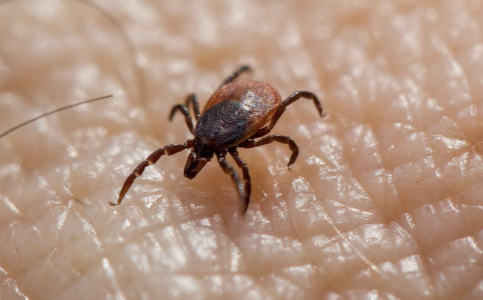The surprising link between tick bites and allergies—plus one $5 tool that can help
By
Veronica E.
- Replies 0
Spending time outside is something many people enjoy, from gardening and hiking to relaxing in the yard.
But in recent years, more Americans have developed a strange allergy to red meat—triggered by a single tick bite.
Known as alpha-gal syndrome, the condition can cause serious reactions hours after eating beef, pork, or lamb.
As tick season ramps up, experts are raising awareness about the growing risk.
Fortunately, there’s one simple and inexpensive tool that might help prevent it.

What is alpha-gal syndrome, and how do ticks trigger it?
Alpha-gal syndrome is a serious allergic reaction to a sugar molecule called galactose-alpha-1,3-galactose (alpha-gal), which is found in most mammal meats, such as beef, pork, and lamb.
This condition can be triggered by a bite from the lone star tick—a species once limited to the Southeast but now spreading farther north.
When the tick bites a person, it can transmit alpha-gal into their system.
Over time, this may cause the body to treat red meat as a threat, leading to allergic reactions that range from hives to difficulty breathing.
Symptoms often occur several hours after eating, which makes the condition difficult to diagnose.
Also read: ER visits tied to a growing parasite concern are on the rise—what to know this season
Cases are rising, but so is awareness
According to the Centers for Disease Control and Prevention (CDC), antibodies linked to alpha-gal syndrome increased by 41% in tested blood samples between 2017 and 2021.
While the condition remains rare, thousands of people may now be affected—and some may not yet know the cause of their symptoms.
The $5 tool that could help keep ticks away
A simple lint roller—the same kind used to remove pet hair from clothes—is gaining attention as a helpful defense tool against ticks.
Conservationists and Lyme disease advocates recommend using it to roll over your clothing, shoes, and pets after spending time outdoors.
This works best on ticks that haven’t yet latched onto the skin.
Since ticks often wander around the body before attaching, the lint roller may catch them before they can bite.
It’s especially helpful for catching nymphs and larvae, which are extremely small and easy to miss.
Also read: Experts urge caution as tick-borne diseases reach alarming levels
When to use other removal tools
If a tick has already attached, a lint roller won’t be effective.
In that case, use fine-tipped tweezers or a tick removal tool to grasp the tick as close to the skin as possible and pull it out slowly and straight.
Avoid twisting or jerking, which can leave parts of the tick behind and increase infection risk.
After removal, clean the bite site and monitor for symptoms like rashes or fever.
Also read: An invasive insect is making its way through 19 US states—is your hometown in danger?
Other ways to stay safe outdoors
Experts recommend the following steps to reduce your risk of tick bites:

Also read: Are "Killer Bees" heading for your neighborhood? Here’s what you need to know to stay safe
Don’t forget other tick-borne illnesses
While the lone star tick is known for causing alpha-gal syndrome, other ticks can transmit diseases as well.
Blacklegged (deer) ticks spread Lyme disease, while dog ticks and Rocky Mountain wood ticks can carry serious infections like Rocky Mountain spotted fever.
The lint roller method can help reduce your risk of all of these by removing ticks early.
Also read: Alien base or military secret? The mountain where 66 humans allegedly died
A bit of prevention goes a long way
Most tick bites won’t lead to illness, especially if caught early.
But it only takes one bite to create long-lasting effects.
With a $5 lint roller and a few smart habits, you can keep enjoying the outdoors safely—and maybe even avoid an allergy that changes your diet for good!
Read next: Do your supermarket plants always die? Here’s what experts want you to know

Have you ever dealt with a tick bite or found your own ways to stay tick-free? We’d love to hear from you in the comments. Sharing your story could help others protect themselves, too!
But in recent years, more Americans have developed a strange allergy to red meat—triggered by a single tick bite.
Known as alpha-gal syndrome, the condition can cause serious reactions hours after eating beef, pork, or lamb.
As tick season ramps up, experts are raising awareness about the growing risk.
Fortunately, there’s one simple and inexpensive tool that might help prevent it.

As tick season begins, experts recommend easy prevention methods to help reduce the risk of tick-borne illnesses while enjoying the outdoors. Image Source: Pexels / Erik Karits.
What is alpha-gal syndrome, and how do ticks trigger it?
Alpha-gal syndrome is a serious allergic reaction to a sugar molecule called galactose-alpha-1,3-galactose (alpha-gal), which is found in most mammal meats, such as beef, pork, and lamb.
This condition can be triggered by a bite from the lone star tick—a species once limited to the Southeast but now spreading farther north.
When the tick bites a person, it can transmit alpha-gal into their system.
Over time, this may cause the body to treat red meat as a threat, leading to allergic reactions that range from hives to difficulty breathing.
Symptoms often occur several hours after eating, which makes the condition difficult to diagnose.
Also read: ER visits tied to a growing parasite concern are on the rise—what to know this season
Cases are rising, but so is awareness
According to the Centers for Disease Control and Prevention (CDC), antibodies linked to alpha-gal syndrome increased by 41% in tested blood samples between 2017 and 2021.
While the condition remains rare, thousands of people may now be affected—and some may not yet know the cause of their symptoms.
The $5 tool that could help keep ticks away
A simple lint roller—the same kind used to remove pet hair from clothes—is gaining attention as a helpful defense tool against ticks.
Conservationists and Lyme disease advocates recommend using it to roll over your clothing, shoes, and pets after spending time outdoors.
This works best on ticks that haven’t yet latched onto the skin.
Since ticks often wander around the body before attaching, the lint roller may catch them before they can bite.
It’s especially helpful for catching nymphs and larvae, which are extremely small and easy to miss.
Also read: Experts urge caution as tick-borne diseases reach alarming levels
When to use other removal tools
If a tick has already attached, a lint roller won’t be effective.
In that case, use fine-tipped tweezers or a tick removal tool to grasp the tick as close to the skin as possible and pull it out slowly and straight.
Avoid twisting or jerking, which can leave parts of the tick behind and increase infection risk.
After removal, clean the bite site and monitor for symptoms like rashes or fever.
Also read: An invasive insect is making its way through 19 US states—is your hometown in danger?
Other ways to stay safe outdoors
Experts recommend the following steps to reduce your risk of tick bites:
- Wear long sleeves and pants, and choose light-colored clothing so ticks are easier to spot.
- Use EPA-registered repellents with DEET, picaridin, or permethrin (on clothing).
- Shower within two hours of being outside to help wash off ticks before they attach.
- Regularly check yourself, your children, and your pets for ticks, especially behind the knees, under arms, around the waistband, and on the scalp.

A lint roller, often used for clothes, can double as a handy tool to pick up ticks after spending time outside. Image Source: Pexels / cottonbro studio.
Also read: Are "Killer Bees" heading for your neighborhood? Here’s what you need to know to stay safe
Don’t forget other tick-borne illnesses
While the lone star tick is known for causing alpha-gal syndrome, other ticks can transmit diseases as well.
Blacklegged (deer) ticks spread Lyme disease, while dog ticks and Rocky Mountain wood ticks can carry serious infections like Rocky Mountain spotted fever.
The lint roller method can help reduce your risk of all of these by removing ticks early.
Also read: Alien base or military secret? The mountain where 66 humans allegedly died
A bit of prevention goes a long way
Most tick bites won’t lead to illness, especially if caught early.
But it only takes one bite to create long-lasting effects.
With a $5 lint roller and a few smart habits, you can keep enjoying the outdoors safely—and maybe even avoid an allergy that changes your diet for good!
Read next: Do your supermarket plants always die? Here’s what experts want you to know
Key Takeaways
- Alpha-gal syndrome is a red meat allergy linked to bites from the lone star tick, and cases are rising across the US as the tick spreads northward.
- The allergy is caused by a sugar molecule found in mammalian meat, and symptoms can range from mild rashes to severe, delayed allergic reactions.
- Health experts recommend using a basic lint roller on clothing and pets after outdoor activities to remove ticks before they attach.
- The lint roller method is effective only for unattached ticks; embedded ticks must be removed with tweezers or a specialized tick-removal tool.
Have you ever dealt with a tick bite or found your own ways to stay tick-free? We’d love to hear from you in the comments. Sharing your story could help others protect themselves, too!






